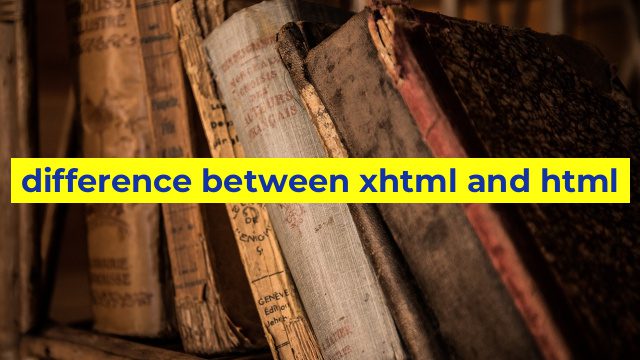What is XHTML?
XHTML stands for Extensible HyperText Markup Language. It is a markup language that is based on HTML and XML. XHTML follows the rules and guidelines of XML, which requires strict syntax and well-formed documents. XHTML documents need to have the proper structure, strict syntax, and follow strict syntax rules.
What is HTML?
HTML stands for HyperText Markup Language. It is a markup language that is used to create web pages. HTML is widely used because it is easy to learn and can be read by any web browser. HTML codes are kept simple and written in a more lenient syntax than XHTML. This makes it much easier for novice web developers to read, understand, and create web pages.
What is the Difference between XHTML and HTML?
The fundamental difference between the two markup languages is how they parse and follow the rules of syntax. XHTML follows the rules and guidelines of XML, requiring strict syntax and well-formed documents. XHTML documents need to have the proper structure, strict syntax and follow strict compiling rules. On the other hand, HTML is more lenient in its syntax, making it more straightforward for beginner web developers to understand.
Another difference between XHTML and HTML is how browsers filter errors. When an XHTML document has even the slightest mistake, such as a missing end tag, the XML rules will require that the document stops parsing, and the error must be fixed for the document to be shown. In contrast, HTML, which is more lenient in its code syntax, allows for browsers to filter through errors and continue to display web pages correctly.
The Bottom Line
Although XHTML and HTML are similar in many ways, the key differences are their parsing and coding syntax. XHTML adheres to the structure and syntax rules of XML, which leads to more well-structured and correctly-formed documents. HTML is more flexible in its syntax and allows novice developers to create web pages quickly and easily. In summary, choose the markup language that best suits your needs and goals for your web development projects.
Table difference between xhtml and html
| Difference between XHTML and HTML |
| — |
| XHTML (Extensible Hypertext Markup Language) is a stricter, more structured version of HTML (Hypertext Markup Language). |
| In XHTML, all tags must be properly closed, and all elements must be nested correctly. In HTML, it is more forgiving and allows tags to be left unclosed or improperly nested. |
| XHTML requires that all tags and attributes be lowercase. HTML does not have this requirement. |
| XHTML requires that all attributes have values wrapped in quotes. HTML allows some attributes to be unquoted. |
| XHTML requires that all tags have a closing tag, even if the tag is empty. HTML allows some empty tags to be left unclosed. |
| XHTML mandates the use of XML-style closing tags for empty elements, such as `
` instead of the traditional HTML format of `
`. |
Overall, XHTML is a stricter and more structured version of HTML, with a focus on adherence to rules and consistency. HTML is more lenient and forgiving, allowing for some sloppiness in coding.


